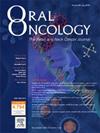Histological tumor necrosis predicts decreased survival after neoadjuvant chemotherapy in head and neck squamous cell carcinoma
IF 4
2区 医学
Q1 DENTISTRY, ORAL SURGERY & MEDICINE
引用次数: 0
Abstract
Objective
Despite growing interest in neoadjuvant therapies, there are no methods to predict radio- (RT) or chemoradiotherapy (CRT) response in head and neck squamous cell carcinoma (HNSCC). The aim of this research was to study the effect of neoadjuvant RT or CRT on the tumor immune landscape and patient survival in HNSCC.
Methods
All HNSCC patients treated with neoadjuvant RT or CRT (n = 53) were identified from a retrospective cohort of 1033 patients. Pre- and post-neoadjuvant cancer samples from the same patient were analyzed with biomarkers related to cancer immunology: tumor-infiltrating lymphocytes (CD8), tumor-associated macrophages (CD68, CD206, Clever-1), immune response regulator (PD-L1) and histologic tumor necrosis. Outcomes of interest were individual immune landscape profiling and its impact on 5-year overall survival (OS) in HNSCC patients treated with neoadjuvant RT/CRT.
Results
Results from 588 whole-section stainings revealed multiple statistically significant alterations in immune landscape in response to RT/CRT. Pretreatment tumor necrosis was the most useful biomarker in predicting poor outcome, as the OS was 14.3% with necrosis and 48.5% without necrosis (HR 2.87; 95% CI: 1.23 to 6.66, p=0.014). In addition, an artificial intelligence-based (AI) deep learning method for identifying tumor necrosis from histopathological specimens was successfully developed. The predictive role of histological necrosis in neoadjuvant RT/CRT was validated in additional samples from 171 HNSCC patients untreated with neoadjuvant therapy.
Conclusions
Detection of tumor necrosis and AI-driven deep learning effectively predict neoadjuvant RT/CRT responses in HNSCC.
组织学肿瘤坏死预测头颈部鳞状细胞癌新辅助化疗后生存率降低
目的尽管人们对新辅助治疗越来越感兴趣,但目前还没有方法预测头颈部鳞状细胞癌(HNSCC)的放疗(RT)或放化疗(CRT)反应。本研究的目的是研究新辅助RT或CRT对HNSCC肿瘤免疫景观和患者生存的影响。方法回顾性分析1033例接受新辅助放疗或CRT治疗的HNSCC患者(53例)。对同一患者的新辅助治疗前和后肿瘤样本进行肿瘤免疫学相关生物标志物分析:肿瘤浸润淋巴细胞(CD8)、肿瘤相关巨噬细胞(CD68、CD206、clevi -1)、免疫反应调节因子(PD-L1)和组织学肿瘤坏死。结果感兴趣的是个体免疫景观分析及其对接受新辅助RT/CRT治疗的HNSCC患者5年总生存率(OS)的影响。结果588例全切片染色显示,RT/CRT对免疫景观的影响有统计学意义。预处理肿瘤坏死是预测不良预后最有用的生物标志物,有坏死的OS为14.3%,无坏死的OS为48.5% (HR 2.87;95% CI: 1.23 ~ 6.66, p=0.014)。此外,成功开发了一种基于人工智能(AI)的深度学习方法,用于从组织病理标本中识别肿瘤坏死。在171例未经新辅助治疗的HNSCC患者的额外样本中,组织学坏死在新辅助RT/CRT中的预测作用得到了验证。结论肿瘤坏死检测和人工智能驱动的深度学习可有效预测HNSCC的新辅助RT/CRT反应。
本文章由计算机程序翻译,如有差异,请以英文原文为准。
求助全文
约1分钟内获得全文
求助全文
来源期刊

Oral oncology
医学-牙科与口腔外科
CiteScore
8.70
自引率
10.40%
发文量
505
审稿时长
20 days
期刊介绍:
Oral Oncology is an international interdisciplinary journal which publishes high quality original research, clinical trials and review articles, editorials, and commentaries relating to the etiopathogenesis, epidemiology, prevention, clinical features, diagnosis, treatment and management of patients with neoplasms in the head and neck.
Oral Oncology is of interest to head and neck surgeons, radiation and medical oncologists, maxillo-facial surgeons, oto-rhino-laryngologists, plastic surgeons, pathologists, scientists, oral medical specialists, special care dentists, dental care professionals, general dental practitioners, public health physicians, palliative care physicians, nurses, radiologists, radiographers, dieticians, occupational therapists, speech and language therapists, nutritionists, clinical and health psychologists and counselors, professionals in end of life care, as well as others interested in these fields.
 求助内容:
求助内容: 应助结果提醒方式:
应助结果提醒方式:


